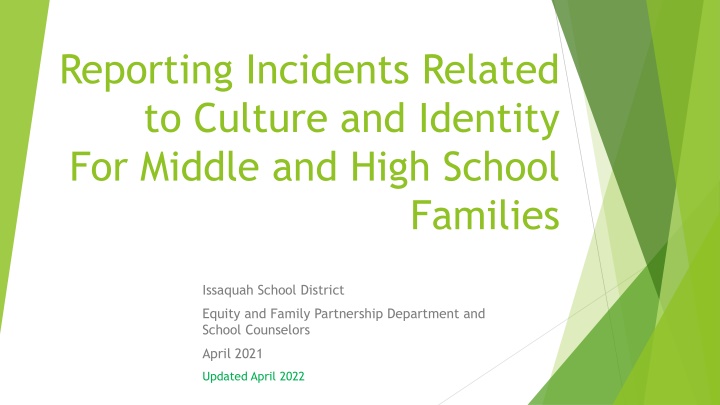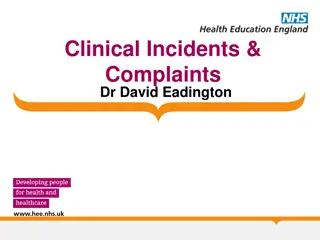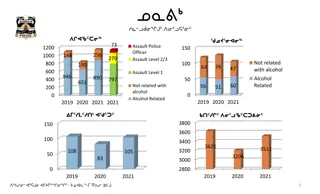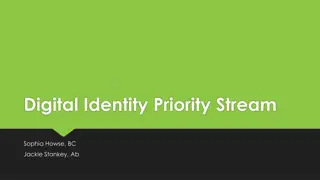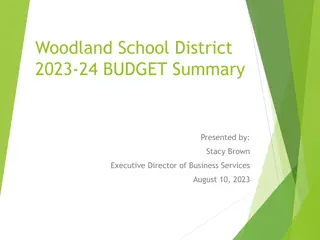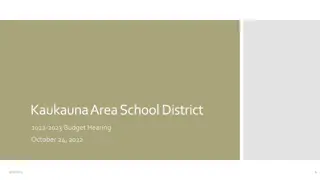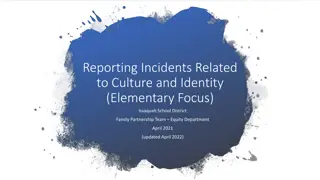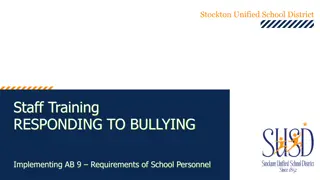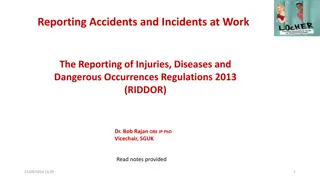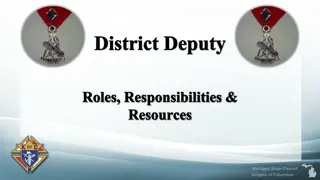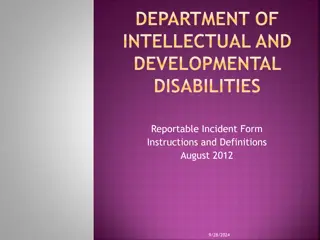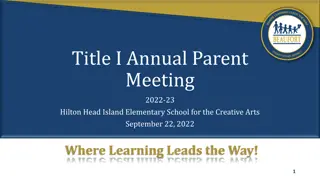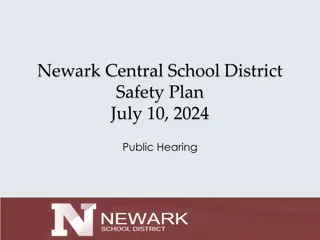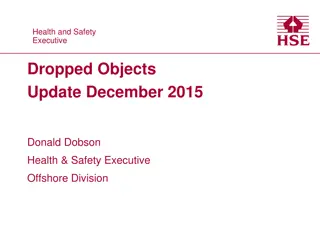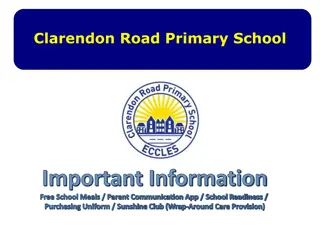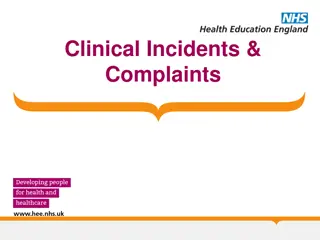Responding to Incidents Related to Culture and Identity in Issaquah School District: Parent Workshop Summary
In this session by the Equity and Family Partnership Department along with school counselors in Issaquah School District, parents were guided on how to support their children in reporting and responding to incidents related to culture and identity at middle and high school levels. The importance of creating a safe and positive environment within the school community was emphasized, with a focus on addressing racist remarks, bullying, harassment, and intimidation. The session aimed to empower parents with knowledge on whom and how to report such incidents, along with the role of the school in providing support and follow-up.
Download Presentation

Please find below an Image/Link to download the presentation.
The content on the website is provided AS IS for your information and personal use only. It may not be sold, licensed, or shared on other websites without obtaining consent from the author.If you encounter any issues during the download, it is possible that the publisher has removed the file from their server.
You are allowed to download the files provided on this website for personal or commercial use, subject to the condition that they are used lawfully. All files are the property of their respective owners.
The content on the website is provided AS IS for your information and personal use only. It may not be sold, licensed, or shared on other websites without obtaining consent from the author.
E N D
Presentation Transcript
Reporting Incidents Related to Culture and Identity For Middle and High School Families Issaquah School District Equity and Family Partnership Department and School Counselors April 2021 Updated April 2022
English session (please see links to sessions in Chinese and Spanish in the Chat). Some reminders please put your microphones on mute Welcome Enter questions in chat and staff will respond to group Parents can ask questions at the end of the session This presentation was recorded earlier. I will be posting the video and PowerPoint presentation on the Cultural and Family Partnership webpage by Friday (Delay so that we can get the YouTube video subtitled translated if possible) Cultural and Family Partnership
Lorna Gilmour Family Partnership Specialist Julia Bamba Principal of Gibson Ek Miranda Williams School Counselor at PCMS Introduction of Presenters Videos by: Stacy Clawson Secondary School Counselor Specialist Stacey Zachau HIB Compliance Coordinator, Assistant Director of Student Interventions
Objective: Parent workshop on how to respond to incidents related to culture and identity What does the school do to support students in middle and high school in reporting incidents? To whom and how to report incidents related to culture and identity. Follow up from school when incident is reported. Definitions of terms Racist remarks, bullying, harassment and intimidation What can parents do to support their child.
ISD Safe and Positive Environment The Issaquah School District believes that a safe, civil environment is essential to high student and staff achievement, to the free exchange of ideas central to a quality educational process, and to the development of youth as thoughtful participants in our democracy. Conversely, uncivil conduct, like other forms of disruptive behavior, interferes with a student s ability to learn and a school s ability to educate its students. The Issaquah School District strives to maintain a learning environment where all students, staff and members of our community can be free from intimidation and harassment. One way we foster such an environment is by informing students and employees--as well as parents--of their personal rights. We explain proper behavior in schools and what kinds of behavior are inappropriate. The District s Regulations on harassment--sexual and otherwise--support our high expectations for proper behavior. Please take a moment to review the summary of Regulation 3205 and 3207, which protect students.
How do schools support students? District Equitable Conduct Policy and EL 16 School administration - Review the school policy at the start of the year (varies by schools announcements, advisory or homeroom classes, other classes), at curriculum night with parents Teachers - Review procedures with students, teachers will often also remind students about school rules and procedures throughout the year (usually after each break). Parents - Review the school policy at the start of the year (September) Listed in the Student Handbook on school website and part of the Enrollment Verification Process in August (Under the "Our School tab Student Handbook) Listed in the School Planner and Student Handbook (Middle and High School) If students enroll later in the year, parents should read the handbook and/or meet with a liaison about general school policies and procedures. Advisory/Homeroom class Middle School- Social Emotional Learning Curriculum called Second Step Bullying Prevention Unit Taught in ISD Middle (and Elementary) Schools from 6thto 8thgrade
Conduct school wide trainings for staff, provide classroom lessons for students, and learning opportunities for parents. Identify students who need help: Provide individual and small group counseling Help families support their student Work with teachers to support classroom success Connect students and families to community resources (food, scholarships, mental health resources) Meet and discuss academic options and including postsecondary options (at high school). 504 Coordinator at the school (Section 504) plan to support students with disabilities that limit daily activities in a major way not special education) What do School Counselors do?
More about the Role of Counselors Social and Emotional Support at Middle and High Schools Not a stigma to talk to counselor support person in school Support for students to overcome challenges and barriers to achievement in school Works with individual and small groups of students in teaching social skills such as making friends and resolving conflicts Works with students about managing feelings Meet and talk with students and parents about social/emotional concerns. Along with the PBSES coach, counselors teach the Social and Emotional Learning (SEL) curriculum Video Role of counselors and their role in bullying prevention and student support
Schools review the policies, including the prohibition of harassment, intimidation and bullying yearly for student body. How do middle and high schools support students? Define harassment, intimidation, and bullying. Discuss the academic, social and physical impacts of HIB Create a safe school community: How to report and who to report How to take action to stand up for each other
Throughout the year Dependent on school Who teaches these lessons and when is it taught? Middle school Advisory/Homeroom most often along with Social Emotional Curriculum Second step curriculum problem solving, conflict resolution, how to navigate relationships, how to participate in creating a safe school environment Taught by PBSES coach, counselor, advisory/homeroom teacher, Dean, Assistant Principal, Principals High School varies by school
Behavior or language that makes a student feel unwelcome or marginalized due to race, heritage, culture, religion or other identity factors Teased or targeted - made fun of for hair, skin color, name, accent, facial features Students may be excluded from groups due to race, religion, or identity Made fun of for their dress (Sikh turban, hijab, other clothing) Made fun of for the food eating at school rice, curry, tofu, noodles, pasta Microaggression - a comment or action that subtly and often unconsciously or unintentionally expresses a prejudiced attitude toward a member of a marginalized group (such as racial minority). As defined by Merriam-Webster. What is racist behavior around culture and ethnicity?
Calling an African American student Ni***r Calling an Asian student Ch**k Go back to Africa or "Go back to China" Examples of racist remarks: Calling an Asian student Coronavirus." "Wuhan virus" Chanting Build a wall Telling a Hispanic student you should be cleaning my house
Examples of microaggressions (also considered racist remarks):
Any student could be the alleged aggressor In cases involving racist remarks, misconception that only white student towards other students of color. Racist incidents, bullying and unkindness is not ALWAYS one race towards another race. Incidents of Asians being unkind or picking on new Asian immigrants (Fresh off the Boat) (Power difference) Incidents of full blood Indian, Chinese or Black students picking on students that are bi-racial or multiracial or vice versa. Incidents from Asian or European students towards Blacks or Hispanic students. Class, socioeconomic level, religion, privilege and power all play roles in such incidents. Sometimes it IS unintentional, uneducated and uninformed behavior Intention vs. impact is discussed with students when incidents happen. At the ISD, schools will work with students to correct such behavior and teach about civility and kindness. Who is doing this?
Students q Building principal, Assistant Principal, Dean of students q Classroom or Specialist Teacher q School Counselor q Bus driver, Paraprofessional (lunch helpers), Nurse, To whom to report the incident? q Custodians q Any trusted adult staff member Parents q Building principal, Assistant Principal, Dean of students q Classroom or Specialist Teacher q School Counselor q Any trusted adult staff member
The Washington State and ISD have clear definitions of HIB terms. Many behaviors that do not rise to the level of harassment, intimidation, or bullying may still be prohibited by other district policies or building, classroom or program rules. Regulations Manual ISD: Definition of Harassment, Intimidation and Bullying Reporting incidents Report the incident so that the school is aware of the concern and can address it. Bullying Resources and Reporting Form to report an incident: 3207FProhibitionAgainstHarassment, Intimidation and Bullying Video by Stacey Zachau HIB Compliance Officer
It can be very hard to distinguish if an incident is a one- off example of mean/unkind behavior or a pattern that is bullying behavior without details and background information. Every situation may be unique and is treated as such by the school administration. Harassment, intimidation, and bullying are separate but related behaviors. Each must be addressed appropriately. Although this procedure differentiates the three behaviors, this differentiation should not be considered part of the legal definition of these behaviors, Behaviors/ Expression Harassment refers to any malicious act, which causes harm to any person's physical well-being. It can be harassment, malicious harassment, or sexual harassment. discriminatory Intimidation refers to implied or overt threats of physical violence. Bullying refers to unwanted aggressive behavior(s) by another student or group of students that involves an observed or perceived power imbalance and is repeated multiple times or is highly likely to be repeated. Bullying may inflict harm on the targeted youth including physical or creates an intimidating or threatening educational environment. Bullying can also occur through technology and is called electronic bullying or cyberbullying
Ask students about their day. What good things happened at school? What was something not positive or good that may have happened? What can parents do to help their child? Proactive Strategies (Before incidents happen) Specific questions: What was lunch, bus ride or class like? You may get one-word answers but be sure to show interest and not give up. Discussions What they would do if someone was being mean to them or bullying them at school? Encourage your child to be an upstander (supportive bystander) and the difference between tattling and reporting Model empathetic behavior- words you use to talk about people of other races. Awareness: Be aware of own prejudice and bias.
Talk to your kids about race and culture. What can parents do to help their child? Proactive Strategies (Before incidents happen) Talk to your kids about kindness and embracing differences not to be colorblind but to recognize differences, being anti-racist Show curiosity learn about other cultures (Read and watch counternarratives) Discuss unkind or bullying behaviors when reading books or watching TV shows. Use these as learning opportunities: ask questions: What would you do? Do you know someone who has experienced this? Who would you talk to if this happened to you? If you saw this happen to someone, how would you help them?
If your child is experiencing unkind behavior or potentially being bullied, he or she might remain quiet out of fear, shame or embarrassment. Warning signs may be vague, and some may mimic mental health issues. Be on the lookout for: Lost or destroyed clothing, electronics or other personal belongings Abrupt loss of friends or avoidance of social situations When parents have concerns warning signs Poor school performance or reluctance to go to school Headaches, stomachaches or other physical complaints Trouble sleeping or frequent nightmares Changes in eating habits Distress after spending time online or on the phone Abrupt avoidance of electronic devices Feelings of helplessness or low self-esteem Self-destructive behavior, such as running away from home Monitor your child s behavior check with child s school counselor if you have concerns
Listen to child Validate child s concerns and feelings Get details - ask questions so that you can get the context of the incident or incidents, names of students or adults involved, where and when it happened What can parents do to help their child? When child reports an incident Consider if it is a problem the school needs to address? How can class teachers, school or counselor address the behavior? Does the behavior need to be monitored? (big problem or minor problem) Ask your child to help you determine how to help them: Can he/she address it on their own? be a coach and mentor Has it been going on for a while? - monitor after child has reported Is it impacting student behavior, academics, etc? How? Depending on age and incident either have the student report or you may report incident to school administrator via an email or phone call. Parents can also fill out an incident report (link in Resource page) Don t expect the child to solve the problem on their own, you may need to intervene and/or monitor Cultural components Parents may want to avoid a problem at school Parents may not want to make a big deal Some cultures and parents are fearful of reporting If you are not sure since new to US school system, ask for help from the School Counselor, Family Partnership Liaison, or other staff
Call or email the School Principal, Assistant Principal or Dean of Students. Include the teacher (if incident is happening in classroom) so they are aware of your concern Parent Reporting an incident For major incidents, parents should contact school administrator by calling, emailing or filing an incident report. Parents can encourage students to report to a trusted adult but are always welcome to follow up with a report or help the child report (model the behavior). Issaquah School District Prohibition Against Harassment, Intimidation and Bullying Incident Reporting Form Any parent or student can also report concerns on Equity or other race related issues here.
School administrator will talk to (interview) the students involved including witnesses to the incident (important to give details of when, who and where if possible). Review previous incidents by student or the person who engaged in the bullying or incident (alleged aggressor) Response by the school Implement corrective measures after investigation- response will depend on unique situation (including if claim was false) Depending on severity of incident corrective measures may include counseling, education, discipline, (referral to law enforcement as appropriate) Response will depend on several factors including incident, age of student, history of behaviors, etc All responses of incident are confidential (from parents reporting, teachers and/or other staff unless they need to be involved).
Parents are not connected with the other parents No public apologies are required by the school Consequences of incident are kept private and confidential Response of school for incidents reported If your child was the complainant (reporting student) Supports are available for them counselor or teacher check-ins, check-in with administrator, etc Retaliation is prohibited by the alleged aggressor or complainant. Students and parents are informed about retaliation in handbook and often in discussions about consequences for the behavior Parent role after reporting an incident Check in with your child, Ask if the situation has improved or resolved Continue to monitor and check in with student, school administrator, teacher and counselor.
Executive Limitation 16 (Equity Work in ISD) Family Resources for Bullying and Cyberbulling Equitable Conduct Policy HIB resources and reporting Issaquah School District Prohibition Against Harassment, Intimidation and Bullying Incident Reporting Form Student Handbook and School Website Resources Video by Stacey Zachau HIB Compliance Officer (2021) Video Role of counselors and their role in bullying prevention and student support Equity Resources for parents: Talking to Kids about race https://www.learningforjustice.org/magazine/spring-2020/lets-talk- about-it
Questions? ISD School staff are here to help you: If you have any questions, please reach out to ISD staff. Classroom teacher School Counselor Building Principal, Assistant Principal or Dean of Students Family Partnership Liaison for help navigating the school ISD HIB (Harassment, Intimidation and Bullying) Coordinator (Compliance Officer) Jordan Frost frostj@issaquah.wednet.edu (425) 837-7109
